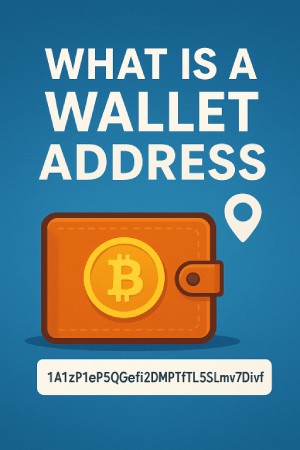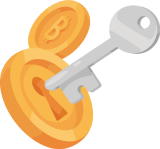What Is a Wallet Address?

A wallet address is a unique combination of alphanumeric characters assigned to the cryptocurrency wallet of a user. It may be thought of as a digital "address" to which cryptocurrencies are sent or received. A wallet address is associated with a particular cryptocurrency wallet that carries out secure storage of digital assets for you. Just like a postal address to which letters or parcels are delivered, a wallet address is where funds are sent and can thus be shared with a receiving party.
Wallet addresses differ from one cryptocurrency to the next. For instance, Bitcoin wallet addresses differ in form from Ethereum wallet addresses. But, regardless of the type of digital assets involved, the role of an address remains the same to allow cryptocurrencies to be transferred safely and correctly between the rightful parties.
Essential Attributes of a Wallet Address
- Uniqueness: Each wallet address is unique, ensuring that cryptocurrencies are directed to the correct wallet.
- Format: The format of a wallet address varies by cryptocurrency. Bitcoin addresses, for example, are typically 26–35 characters long, while Ethereum addresses are usually 42 characters.
- Public Information: While a wallet address is used to receive funds, it is not private. It can be freely shared with others, similar to how you would give someone your email address or phone number.
The Role of Wallet Addresses in Crypto Transactions
Wallet addresses play a fundamental role in ensuring that crypto transactions are executed smoothly. When you send or receive cryptocurrency, it is essential to have the correct wallet address to avoid errors or loss of funds. Here’s a breakdown of how wallet addresses function during transactions:
Sending Funds
While the sender enters a payment instruction to send a certain amount to another party, the first requirement is for the sender to provide the receiver's wallet address. Here is a glimpse of the generic flow.
- Initiation of the Transaction: You enter the amount you wish to send and input the address of the recipient's wallet.
- Verification: The system will verify if the address is a correct address for a certain kind of cryptocurrency.
- Broadcasting of Transaction: After verification, transaction gets broadcast over the network for miners or validators to process the transactions.
- Fund Confirmation: Once confirmed several times, the balance on the recipient's wallet will reveal the funds that have been deposited.
Receiving Funds
Receiving funds is as simple as sending themр but it starts with you providing your wallet address to the sender. Here's what happens when someone sends you crypto:
- Giving Your Address: You give the sender your wallet address, which consists of strings of characters.
- Transaction Initiation: Your wallet address enters the sender's wallet interface. Once the sender clicks "confirm," the transaction is broadcast into the network.
- Confirmation: Post network confirmation of the transaction, your wallet balance gets updated.
Examples of Wallet Addresses
Different cryptocurrencies have different formats for wallet addresses. Below are examples of wallet addresses from some popular cryptocurrencies:

Bitcoin Wallet Address
A bitcoin wallet address usually begins with a "1" or "3" and is between 26 and 35 characters long. Below is an example:
1A1zP1eP5QGefi2DMPTfTL5SLmv7DivfNa
Ethereum Wallet Address
The Ethereum address starts with a 0x prefix followed by 40 hexadecimal characters. Here is an example:
0x32Be343B94f860124dC4fEe278FDCBD38C102D88
Litecoin Wallet Address
Litecoin address looks almost the same as that of a Bitcoin address. Here's an example:
LZpYN3Am6V8ZZzGtd5tbdmxt5Xo6kW9hxD
Wallet Address vs. Public Key

The wallet address is closely tied to the idea of a public key. The public key is the cryptography string of characters used to create a wallet address. In simpler terms, your public key is a foundation on which your wallet address is based and can also be used to verify that the transaction is legitimate.
Usually, 'public key' is required for the creation of a wallet address, and the wallet address itself is what is generally shared for receiving funds. The public key is hardly shared directly for transactions since it is more of an abstract concept, which means it is not easy to understand or access as compared to wallet addresses.
Keeping Your Wallet Address Safe 🛡️
While wallet addresses are not ordinarily something that one might worry about as far as security is concerned, the security of your private keys and making certain that the right address is being used in the transactions are much more important. Safe attempts include:
- Double Check: Always double-check the wallet address before sending any cryptocurrency.
- Trusted Wallets: A reputable cryptocurrency wallet and service should be used to reduce the risks of phishing or scam attempts.
- Private Key Security: Keep your private keys safe and dry. Never give these to anyone.
Protect Your Funds with the Right Address 💰
A wallet address is a very important facet of the crypto environment, allowing users to send and receive cryptocurrencies securely. Knowing how a wallet address works and its role in crypto transactions is essential for anyone venturing into the world of digital assets. Always check the correct wallet address, for these addresses are public; obviously, their private keys must be kept secret to secure their funds.
In case you missed
There are two main types of wallet:
— Defi Krab 🦀 (@Defi_Krab) August 16, 2025
1. Hot Wallet: These are online wallets. We can download them on our devices (Less secure).
Eg: Metamask, Solflare, Nightly...
2. Cold Wallet: These are offline wallets. It is a physical type of wallet (more secure).
Eg: Ledger, Keystone... pic.twitter.com/RiChEJRNq1